Business Law: Analysis of Negligent Misstatement and Contract Breach
VerifiedAdded on 2020/05/16
|8
|1613
|77
Report
AI Summary
This report delves into the legal concept of negligent misstatement within the framework of tort law, using Ellen's case as a central example. It examines the key elements required to establish a claim for negligent misstatement, including duty of care, breach of duty, and causation of damages. The report analyzes relevant case law, such as Morgan Crucible v Hill Samuel Bank and Dulieu v White, to illustrate the application of legal principles. Furthermore, the report explores the issue of contract frustration in relation to Ellen's situation, arguing that her contract with the landlord was likely discharged due to frustration caused by her nervous disorder. The conclusion supports Ellen's claim against the council officer for negligent misstatement and clarifies that there was no breach of contract due to frustration.
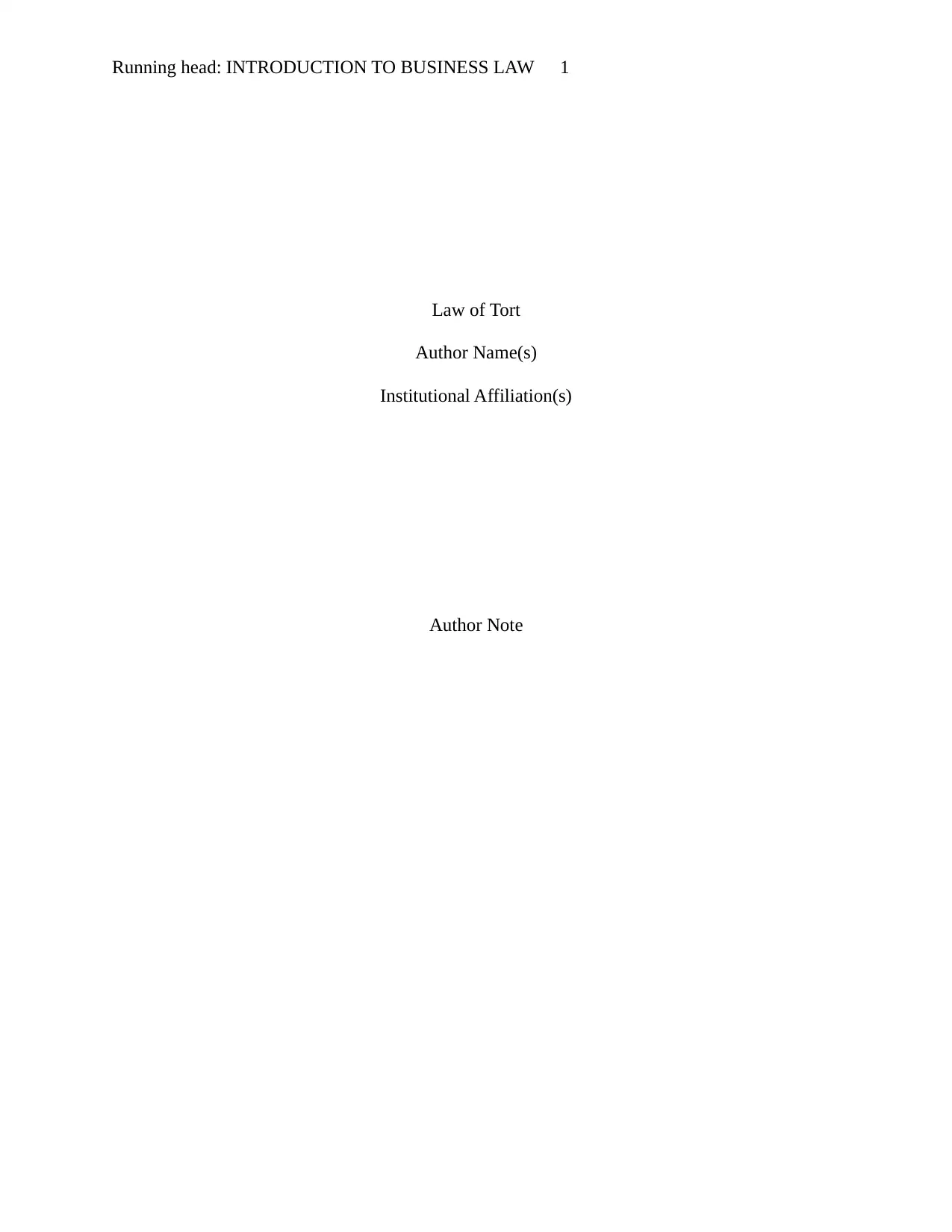
Running head: INTRODUCTION TO BUSINESS LAW 1
Law of Tort
Author Name(s)
Institutional Affiliation(s)
Author Note
Law of Tort
Author Name(s)
Institutional Affiliation(s)
Author Note
Paraphrase This Document
Need a fresh take? Get an instant paraphrase of this document with our AI Paraphraser
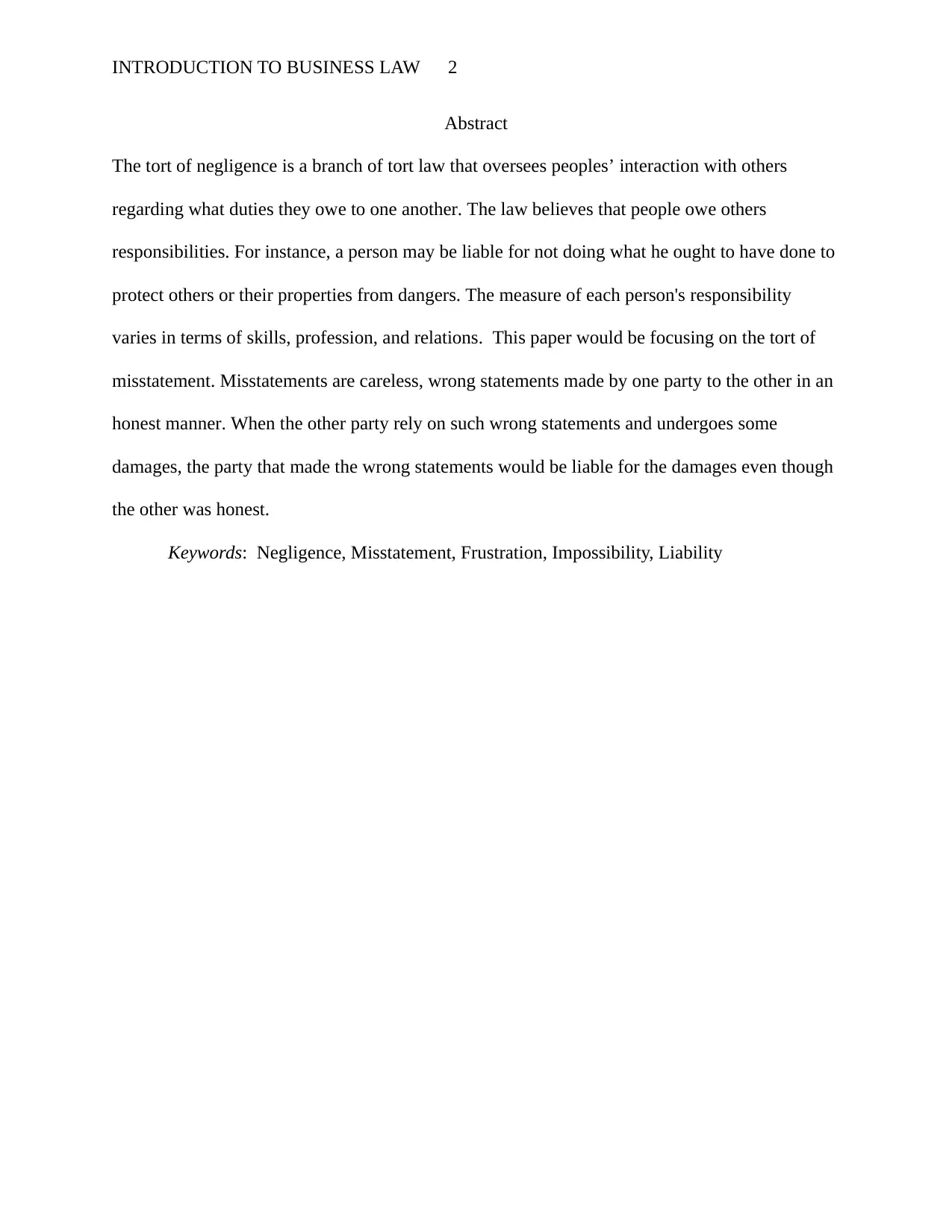
INTRODUCTION TO BUSINESS LAW 2
Abstract
The tort of negligence is a branch of tort law that oversees peoples’ interaction with others
regarding what duties they owe to one another. The law believes that people owe others
responsibilities. For instance, a person may be liable for not doing what he ought to have done to
protect others or their properties from dangers. The measure of each person's responsibility
varies in terms of skills, profession, and relations. This paper would be focusing on the tort of
misstatement. Misstatements are careless, wrong statements made by one party to the other in an
honest manner. When the other party rely on such wrong statements and undergoes some
damages, the party that made the wrong statements would be liable for the damages even though
the other was honest.
Keywords: Negligence, Misstatement, Frustration, Impossibility, Liability
Abstract
The tort of negligence is a branch of tort law that oversees peoples’ interaction with others
regarding what duties they owe to one another. The law believes that people owe others
responsibilities. For instance, a person may be liable for not doing what he ought to have done to
protect others or their properties from dangers. The measure of each person's responsibility
varies in terms of skills, profession, and relations. This paper would be focusing on the tort of
misstatement. Misstatements are careless, wrong statements made by one party to the other in an
honest manner. When the other party rely on such wrong statements and undergoes some
damages, the party that made the wrong statements would be liable for the damages even though
the other was honest.
Keywords: Negligence, Misstatement, Frustration, Impossibility, Liability
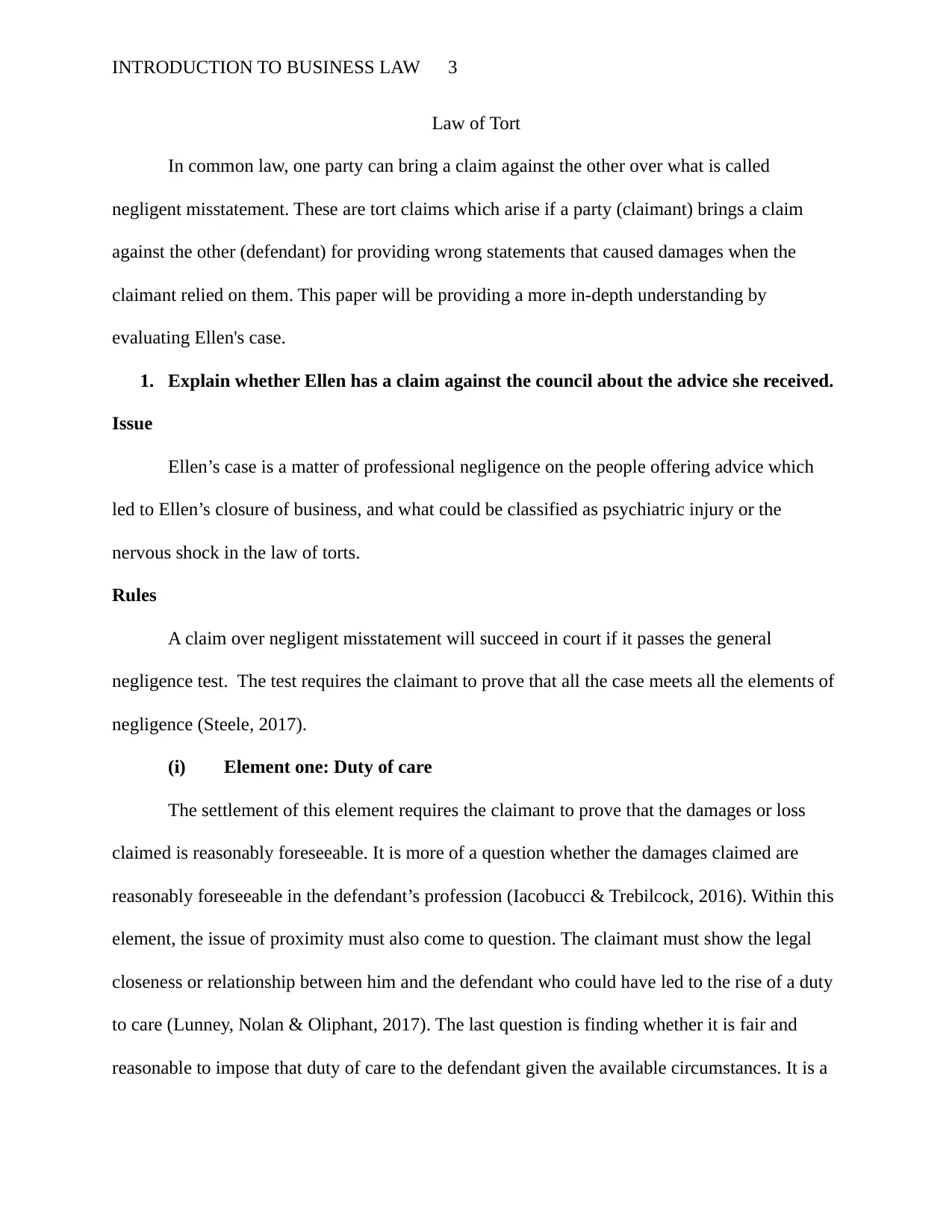
INTRODUCTION TO BUSINESS LAW 3
Law of Tort
In common law, one party can bring a claim against the other over what is called
negligent misstatement. These are tort claims which arise if a party (claimant) brings a claim
against the other (defendant) for providing wrong statements that caused damages when the
claimant relied on them. This paper will be providing a more in-depth understanding by
evaluating Ellen's case.
1. Explain whether Ellen has a claim against the council about the advice she received.
Issue
Ellen’s case is a matter of professional negligence on the people offering advice which
led to Ellen’s closure of business, and what could be classified as psychiatric injury or the
nervous shock in the law of torts.
Rules
A claim over negligent misstatement will succeed in court if it passes the general
negligence test. The test requires the claimant to prove that all the case meets all the elements of
negligence (Steele, 2017).
(i) Element one: Duty of care
The settlement of this element requires the claimant to prove that the damages or loss
claimed is reasonably foreseeable. It is more of a question whether the damages claimed are
reasonably foreseeable in the defendant’s profession (Iacobucci & Trebilcock, 2016). Within this
element, the issue of proximity must also come to question. The claimant must show the legal
closeness or relationship between him and the defendant who could have led to the rise of a duty
to care (Lunney, Nolan & Oliphant, 2017). The last question is finding whether it is fair and
reasonable to impose that duty of care to the defendant given the available circumstances. It is a
Law of Tort
In common law, one party can bring a claim against the other over what is called
negligent misstatement. These are tort claims which arise if a party (claimant) brings a claim
against the other (defendant) for providing wrong statements that caused damages when the
claimant relied on them. This paper will be providing a more in-depth understanding by
evaluating Ellen's case.
1. Explain whether Ellen has a claim against the council about the advice she received.
Issue
Ellen’s case is a matter of professional negligence on the people offering advice which
led to Ellen’s closure of business, and what could be classified as psychiatric injury or the
nervous shock in the law of torts.
Rules
A claim over negligent misstatement will succeed in court if it passes the general
negligence test. The test requires the claimant to prove that all the case meets all the elements of
negligence (Steele, 2017).
(i) Element one: Duty of care
The settlement of this element requires the claimant to prove that the damages or loss
claimed is reasonably foreseeable. It is more of a question whether the damages claimed are
reasonably foreseeable in the defendant’s profession (Iacobucci & Trebilcock, 2016). Within this
element, the issue of proximity must also come to question. The claimant must show the legal
closeness or relationship between him and the defendant who could have led to the rise of a duty
to care (Lunney, Nolan & Oliphant, 2017). The last question is finding whether it is fair and
reasonable to impose that duty of care to the defendant given the available circumstances. It is a
⊘ This is a preview!⊘
Do you want full access?
Subscribe today to unlock all pages.

Trusted by 1+ million students worldwide
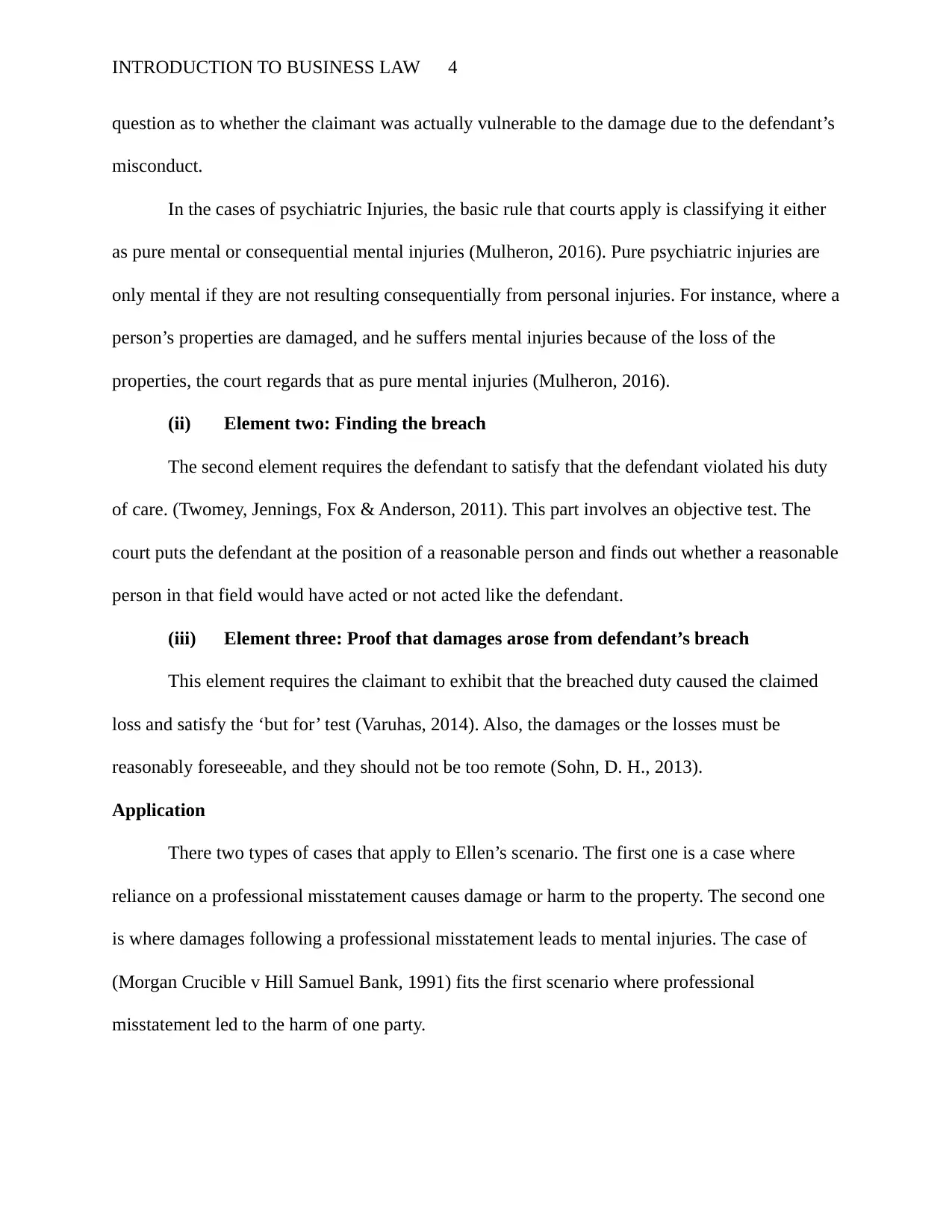
INTRODUCTION TO BUSINESS LAW 4
question as to whether the claimant was actually vulnerable to the damage due to the defendant’s
misconduct.
In the cases of psychiatric Injuries, the basic rule that courts apply is classifying it either
as pure mental or consequential mental injuries (Mulheron, 2016). Pure psychiatric injuries are
only mental if they are not resulting consequentially from personal injuries. For instance, where a
person’s properties are damaged, and he suffers mental injuries because of the loss of the
properties, the court regards that as pure mental injuries (Mulheron, 2016).
(ii) Element two: Finding the breach
The second element requires the defendant to satisfy that the defendant violated his duty
of care. (Twomey, Jennings, Fox & Anderson, 2011). This part involves an objective test. The
court puts the defendant at the position of a reasonable person and finds out whether a reasonable
person in that field would have acted or not acted like the defendant.
(iii) Element three: Proof that damages arose from defendant’s breach
This element requires the claimant to exhibit that the breached duty caused the claimed
loss and satisfy the ‘but for’ test (Varuhas, 2014). Also, the damages or the losses must be
reasonably foreseeable, and they should not be too remote (Sohn, D. H., 2013).
Application
There two types of cases that apply to Ellen’s scenario. The first one is a case where
reliance on a professional misstatement causes damage or harm to the property. The second one
is where damages following a professional misstatement leads to mental injuries. The case of
(Morgan Crucible v Hill Samuel Bank, 1991) fits the first scenario where professional
misstatement led to the harm of one party.
question as to whether the claimant was actually vulnerable to the damage due to the defendant’s
misconduct.
In the cases of psychiatric Injuries, the basic rule that courts apply is classifying it either
as pure mental or consequential mental injuries (Mulheron, 2016). Pure psychiatric injuries are
only mental if they are not resulting consequentially from personal injuries. For instance, where a
person’s properties are damaged, and he suffers mental injuries because of the loss of the
properties, the court regards that as pure mental injuries (Mulheron, 2016).
(ii) Element two: Finding the breach
The second element requires the defendant to satisfy that the defendant violated his duty
of care. (Twomey, Jennings, Fox & Anderson, 2011). This part involves an objective test. The
court puts the defendant at the position of a reasonable person and finds out whether a reasonable
person in that field would have acted or not acted like the defendant.
(iii) Element three: Proof that damages arose from defendant’s breach
This element requires the claimant to exhibit that the breached duty caused the claimed
loss and satisfy the ‘but for’ test (Varuhas, 2014). Also, the damages or the losses must be
reasonably foreseeable, and they should not be too remote (Sohn, D. H., 2013).
Application
There two types of cases that apply to Ellen’s scenario. The first one is a case where
reliance on a professional misstatement causes damage or harm to the property. The second one
is where damages following a professional misstatement leads to mental injuries. The case of
(Morgan Crucible v Hill Samuel Bank, 1991) fits the first scenario where professional
misstatement led to the harm of one party.
Paraphrase This Document
Need a fresh take? Get an instant paraphrase of this document with our AI Paraphraser
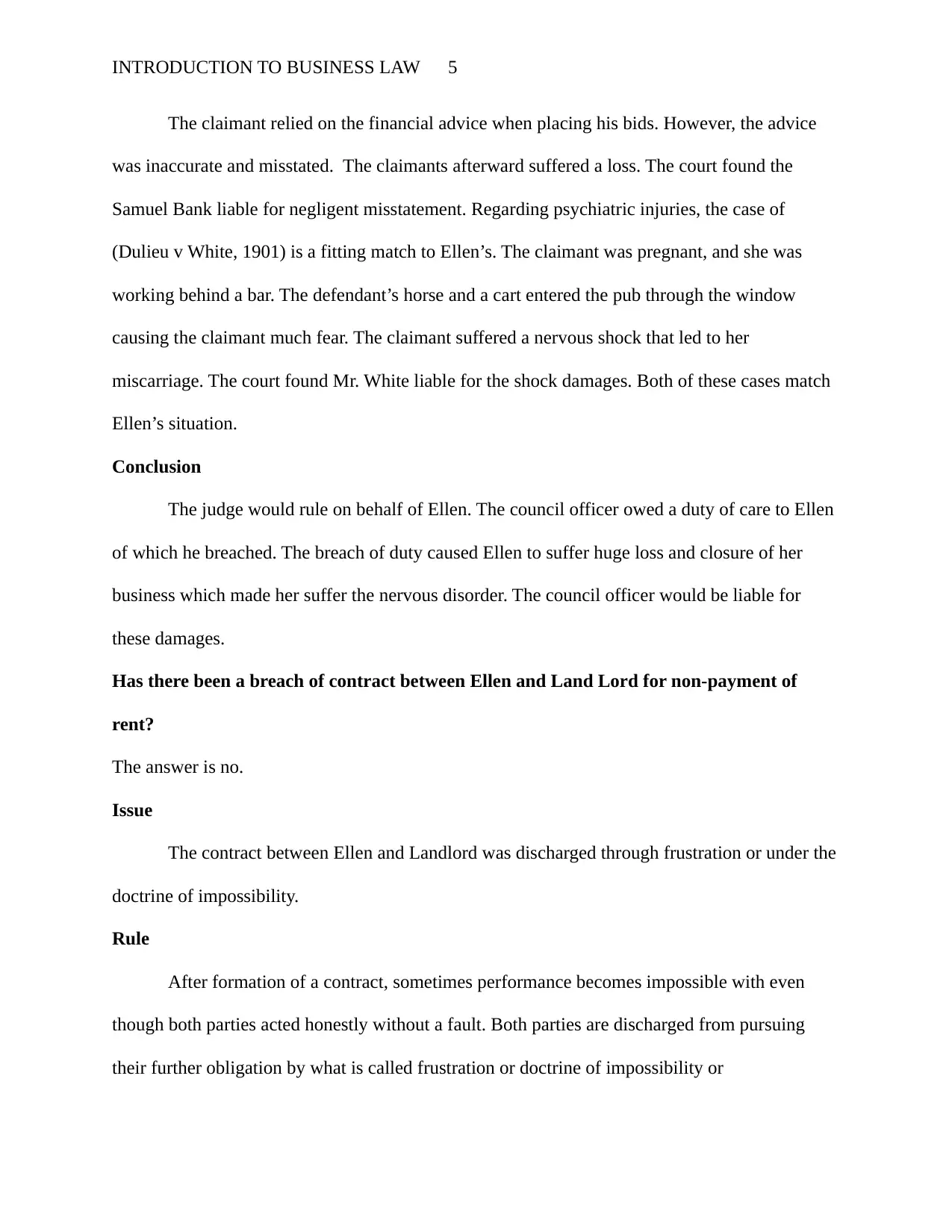
INTRODUCTION TO BUSINESS LAW 5
The claimant relied on the financial advice when placing his bids. However, the advice
was inaccurate and misstated. The claimants afterward suffered a loss. The court found the
Samuel Bank liable for negligent misstatement. Regarding psychiatric injuries, the case of
(Dulieu v White, 1901) is a fitting match to Ellen’s. The claimant was pregnant, and she was
working behind a bar. The defendant’s horse and a cart entered the pub through the window
causing the claimant much fear. The claimant suffered a nervous shock that led to her
miscarriage. The court found Mr. White liable for the shock damages. Both of these cases match
Ellen’s situation.
Conclusion
The judge would rule on behalf of Ellen. The council officer owed a duty of care to Ellen
of which he breached. The breach of duty caused Ellen to suffer huge loss and closure of her
business which made her suffer the nervous disorder. The council officer would be liable for
these damages.
Has there been a breach of contract between Ellen and Land Lord for non-payment of
rent?
The answer is no.
Issue
The contract between Ellen and Landlord was discharged through frustration or under the
doctrine of impossibility.
Rule
After formation of a contract, sometimes performance becomes impossible with even
though both parties acted honestly without a fault. Both parties are discharged from pursuing
their further obligation by what is called frustration or doctrine of impossibility or
The claimant relied on the financial advice when placing his bids. However, the advice
was inaccurate and misstated. The claimants afterward suffered a loss. The court found the
Samuel Bank liable for negligent misstatement. Regarding psychiatric injuries, the case of
(Dulieu v White, 1901) is a fitting match to Ellen’s. The claimant was pregnant, and she was
working behind a bar. The defendant’s horse and a cart entered the pub through the window
causing the claimant much fear. The claimant suffered a nervous shock that led to her
miscarriage. The court found Mr. White liable for the shock damages. Both of these cases match
Ellen’s situation.
Conclusion
The judge would rule on behalf of Ellen. The council officer owed a duty of care to Ellen
of which he breached. The breach of duty caused Ellen to suffer huge loss and closure of her
business which made her suffer the nervous disorder. The council officer would be liable for
these damages.
Has there been a breach of contract between Ellen and Land Lord for non-payment of
rent?
The answer is no.
Issue
The contract between Ellen and Landlord was discharged through frustration or under the
doctrine of impossibility.
Rule
After formation of a contract, sometimes performance becomes impossible with even
though both parties acted honestly without a fault. Both parties are discharged from pursuing
their further obligation by what is called frustration or doctrine of impossibility or
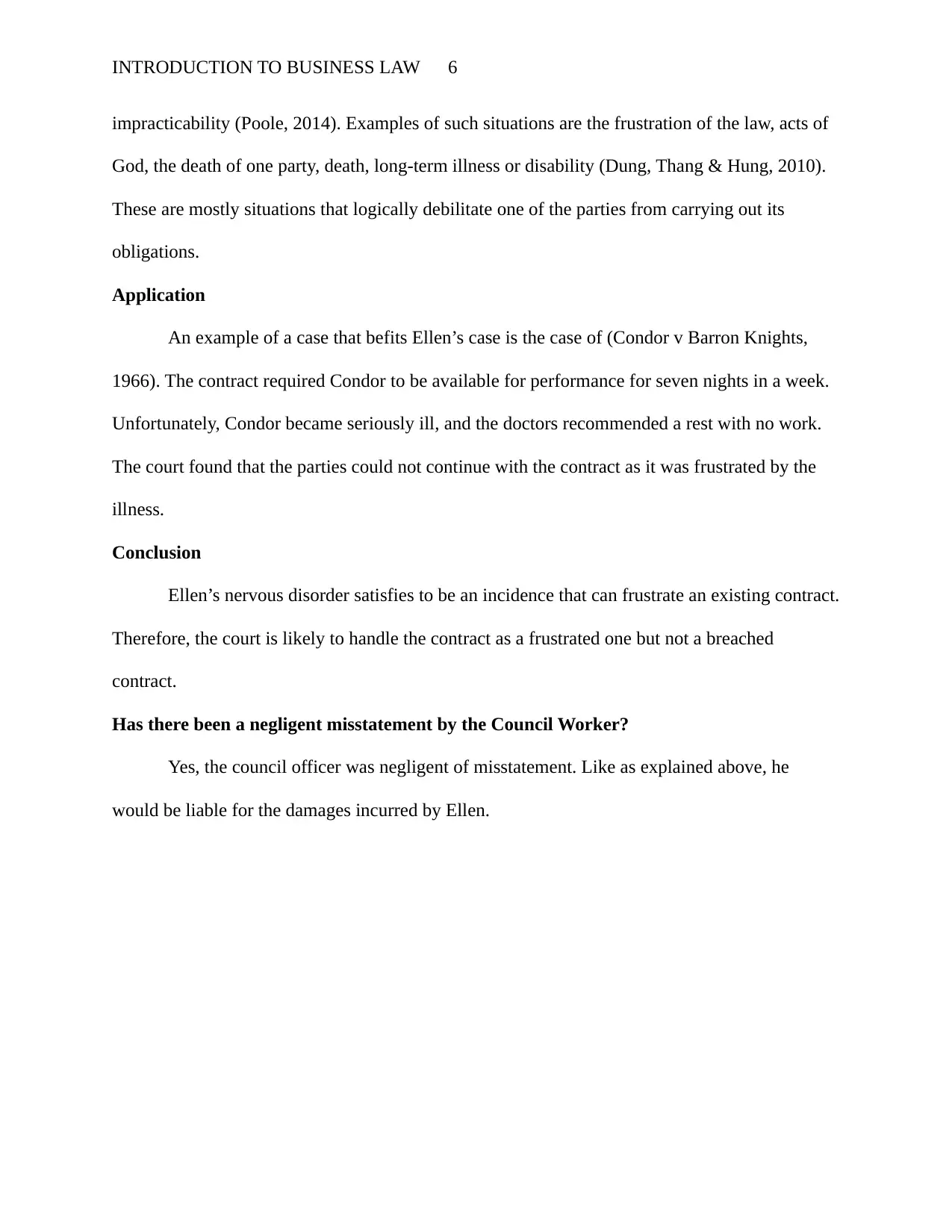
INTRODUCTION TO BUSINESS LAW 6
impracticability (Poole, 2014). Examples of such situations are the frustration of the law, acts of
God, the death of one party, death, long-term illness or disability (Dung, Thang & Hung, 2010).
These are mostly situations that logically debilitate one of the parties from carrying out its
obligations.
Application
An example of a case that befits Ellen’s case is the case of (Condor v Barron Knights,
1966). The contract required Condor to be available for performance for seven nights in a week.
Unfortunately, Condor became seriously ill, and the doctors recommended a rest with no work.
The court found that the parties could not continue with the contract as it was frustrated by the
illness.
Conclusion
Ellen’s nervous disorder satisfies to be an incidence that can frustrate an existing contract.
Therefore, the court is likely to handle the contract as a frustrated one but not a breached
contract.
Has there been a negligent misstatement by the Council Worker?
Yes, the council officer was negligent of misstatement. Like as explained above, he
would be liable for the damages incurred by Ellen.
impracticability (Poole, 2014). Examples of such situations are the frustration of the law, acts of
God, the death of one party, death, long-term illness or disability (Dung, Thang & Hung, 2010).
These are mostly situations that logically debilitate one of the parties from carrying out its
obligations.
Application
An example of a case that befits Ellen’s case is the case of (Condor v Barron Knights,
1966). The contract required Condor to be available for performance for seven nights in a week.
Unfortunately, Condor became seriously ill, and the doctors recommended a rest with no work.
The court found that the parties could not continue with the contract as it was frustrated by the
illness.
Conclusion
Ellen’s nervous disorder satisfies to be an incidence that can frustrate an existing contract.
Therefore, the court is likely to handle the contract as a frustrated one but not a breached
contract.
Has there been a negligent misstatement by the Council Worker?
Yes, the council officer was negligent of misstatement. Like as explained above, he
would be liable for the damages incurred by Ellen.
⊘ This is a preview!⊘
Do you want full access?
Subscribe today to unlock all pages.

Trusted by 1+ million students worldwide
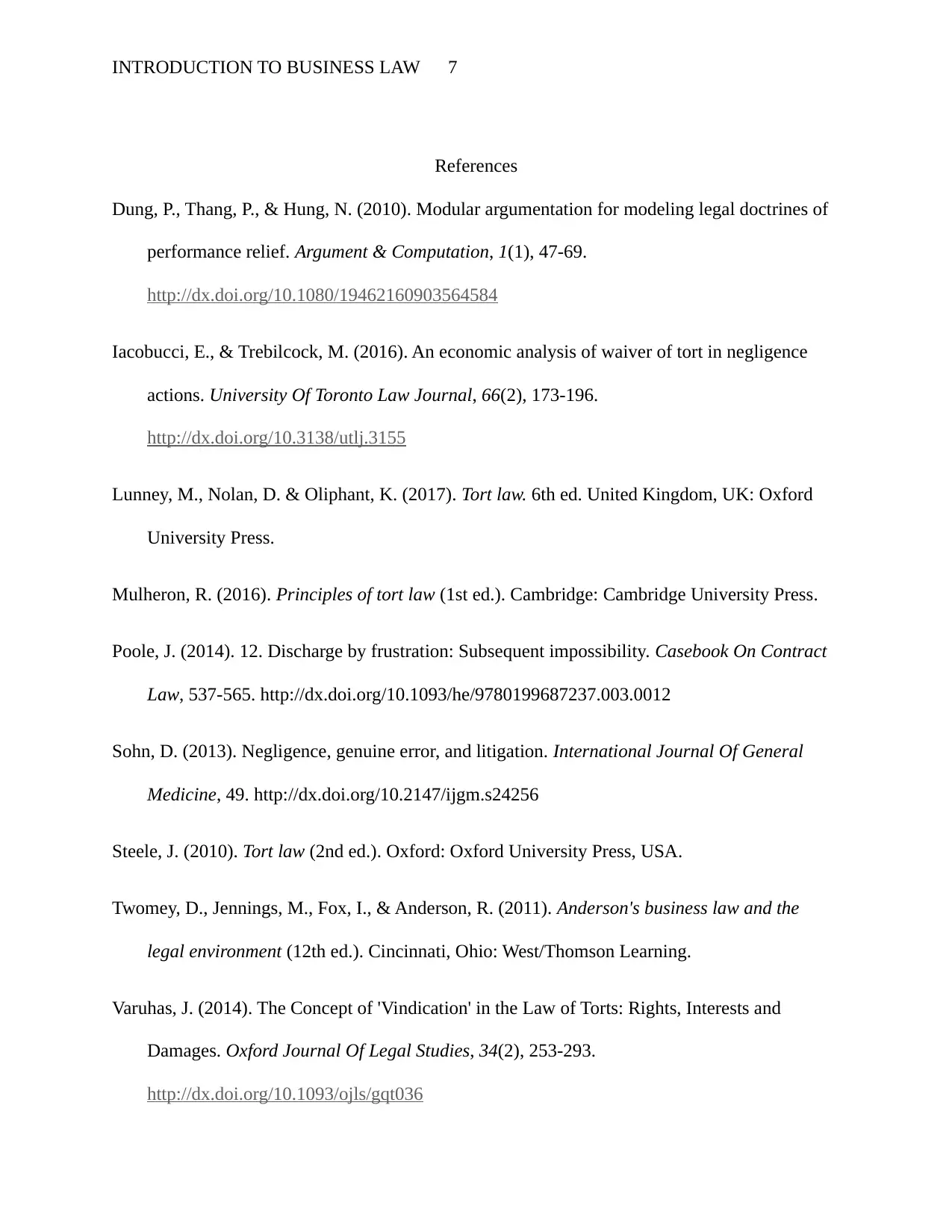
INTRODUCTION TO BUSINESS LAW 7
References
Dung, P., Thang, P., & Hung, N. (2010). Modular argumentation for modeling legal doctrines of
performance relief. Argument & Computation, 1(1), 47-69.
http://dx.doi.org/10.1080/19462160903564584
Iacobucci, E., & Trebilcock, M. (2016). An economic analysis of waiver of tort in negligence
actions. University Of Toronto Law Journal, 66(2), 173-196.
http://dx.doi.org/10.3138/utlj.3155
Lunney, M., Nolan, D. & Oliphant, K. (2017). Tort law. 6th ed. United Kingdom, UK: Oxford
University Press.
Mulheron, R. (2016). Principles of tort law (1st ed.). Cambridge: Cambridge University Press.
Poole, J. (2014). 12. Discharge by frustration: Subsequent impossibility. Casebook On Contract
Law, 537-565. http://dx.doi.org/10.1093/he/9780199687237.003.0012
Sohn, D. (2013). Negligence, genuine error, and litigation. International Journal Of General
Medicine, 49. http://dx.doi.org/10.2147/ijgm.s24256
Steele, J. (2010). Tort law (2nd ed.). Oxford: Oxford University Press, USA.
Twomey, D., Jennings, M., Fox, I., & Anderson, R. (2011). Anderson's business law and the
legal environment (12th ed.). Cincinnati, Ohio: West/Thomson Learning.
Varuhas, J. (2014). The Concept of 'Vindication' in the Law of Torts: Rights, Interests and
Damages. Oxford Journal Of Legal Studies, 34(2), 253-293.
http://dx.doi.org/10.1093/ojls/gqt036
References
Dung, P., Thang, P., & Hung, N. (2010). Modular argumentation for modeling legal doctrines of
performance relief. Argument & Computation, 1(1), 47-69.
http://dx.doi.org/10.1080/19462160903564584
Iacobucci, E., & Trebilcock, M. (2016). An economic analysis of waiver of tort in negligence
actions. University Of Toronto Law Journal, 66(2), 173-196.
http://dx.doi.org/10.3138/utlj.3155
Lunney, M., Nolan, D. & Oliphant, K. (2017). Tort law. 6th ed. United Kingdom, UK: Oxford
University Press.
Mulheron, R. (2016). Principles of tort law (1st ed.). Cambridge: Cambridge University Press.
Poole, J. (2014). 12. Discharge by frustration: Subsequent impossibility. Casebook On Contract
Law, 537-565. http://dx.doi.org/10.1093/he/9780199687237.003.0012
Sohn, D. (2013). Negligence, genuine error, and litigation. International Journal Of General
Medicine, 49. http://dx.doi.org/10.2147/ijgm.s24256
Steele, J. (2010). Tort law (2nd ed.). Oxford: Oxford University Press, USA.
Twomey, D., Jennings, M., Fox, I., & Anderson, R. (2011). Anderson's business law and the
legal environment (12th ed.). Cincinnati, Ohio: West/Thomson Learning.
Varuhas, J. (2014). The Concept of 'Vindication' in the Law of Torts: Rights, Interests and
Damages. Oxford Journal Of Legal Studies, 34(2), 253-293.
http://dx.doi.org/10.1093/ojls/gqt036
Paraphrase This Document
Need a fresh take? Get an instant paraphrase of this document with our AI Paraphraser
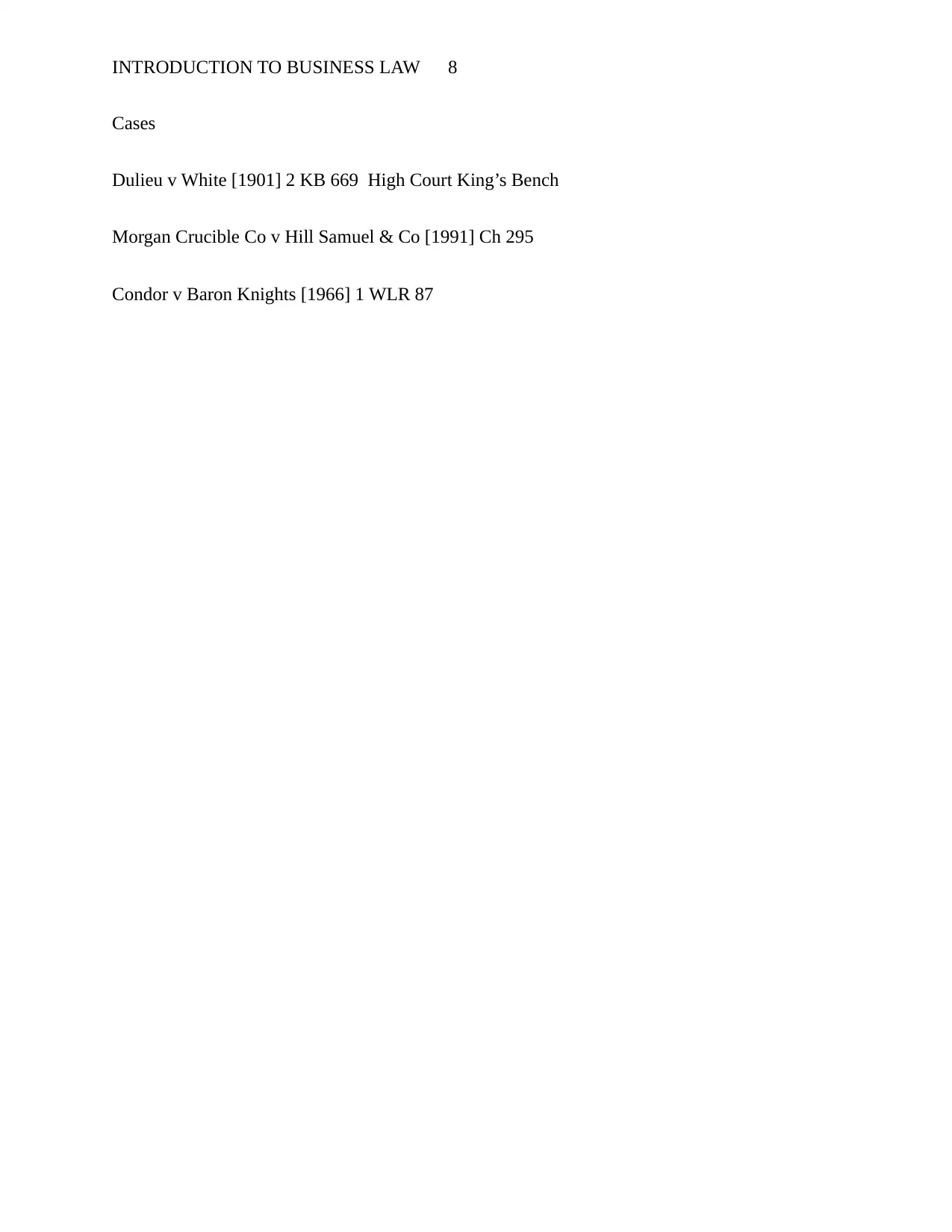
INTRODUCTION TO BUSINESS LAW 8
Cases
Dulieu v White [1901] 2 KB 669 High Court King’s Bench
Morgan Crucible Co v Hill Samuel & Co [1991] Ch 295
Condor v Baron Knights [1966] 1 WLR 87
Cases
Dulieu v White [1901] 2 KB 669 High Court King’s Bench
Morgan Crucible Co v Hill Samuel & Co [1991] Ch 295
Condor v Baron Knights [1966] 1 WLR 87
1 out of 8
Related Documents
Your All-in-One AI-Powered Toolkit for Academic Success.
+13062052269
info@desklib.com
Available 24*7 on WhatsApp / Email
![[object Object]](/_next/static/media/star-bottom.7253800d.svg)
Unlock your academic potential
Copyright © 2020–2025 A2Z Services. All Rights Reserved. Developed and managed by ZUCOL.





